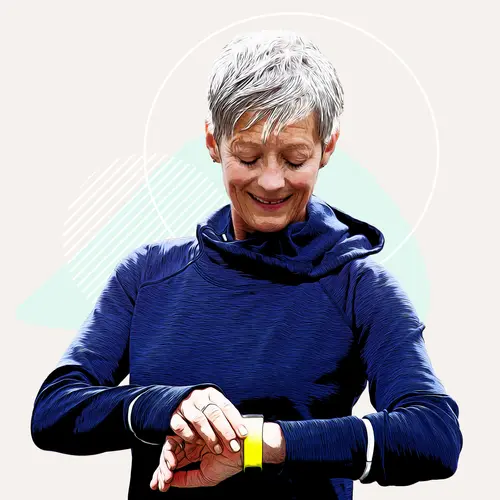As your body ages, it’s common to experience changes to your eye health and vision. According to studies, 1 in 28 Americans over age 40 experiences age-related vision loss — a rate that's expected to double by 2050.
Problems with your eyesight interfere with everyday activities. But there’s growing evidence that it can also put you at a higher risk of:
- Mobility issues and injuries
- Depression and anxiety
- Cognitive decline
- A shortened life expectancy
Genetics and the natural aging process play a role in long-term eye health. But research shows that there are controllable factors that help either lower your risk of visual impairment or slow its progress.
What Happens to Vision as You Age?
Your eyes experience physical changes over time that can affect their proper function, like:
- Loss of flexibility in the lens, impacting its ability to switch near-to-far focus
- Lens discoloration that affects how it processes light
- Reduced strength in the muscle that controls pupil size and its reaction to light
- Lower tear production
On average, these changes begin around age 40 and impact the eye’s focusing ability — a natural progression called presbyopia. The most common effect is experiencing more difficulty in clearly seeing nearby objects, especially in dim lighting.
It’s normal for these age-related eye changes to cause:
- Difficulty in distinguishing colors
- A need for more light to see well and a slower adjustment between dark and bright settings
- Headaches or tired-feeling eyes while reading or other up-close activity
Other common causes of age-related visual decline include conditions like:
Eye floaters. Floaters are tiny spots or specks that drift throughout your field of vision. They occur when the vitreous — a jelly-like substance inside the eye — becomes more liquid as you age. This causes ocular fibers to clump, casting tiny shadows.
Dry eyes. Your eyes’ tear production diminishes as you age. Without enough lubrication to nourish the eye, dry eyes can cause blurred vision and light sensitivity. Dry eyes can also cause uncomfortable stinging, scratching, or burning sensations.
Cataracts. As your eyes’ proteins break down with age, they can begin to form small patches on the lens. These cloudy clusters — or cataracts — keep light from passing to your retina. Cataracts don’t always change your eyesight. But in advanced cases, they may obstruct or blur normal vision.
Glaucoma. Glaucoma results from a change in your eye’s fluid balance. If this interocular pressure increases, it can damage your optic nerve and lead to permanent loss of vision if left untreated. If you have glaucoma, you may experience changes to your periphery or blurred vision as the eye disease progresses. And if you have diabetes or a family history of the condition, you're at greater risk.
Retinal disorders. Your retina is the thin lining on the back of the eye that sends visual information to your brain. Age-related macular degeneration (AMD) is the most common retinal disorder and the leading cause of vision loss in people over 50.
AMD happens due to cell loss in the area of your eye responsible for detailed vision, necessary for things like reading or facial recognition. This distorts your central field of vision, but your peripheral vision remains clear.
Other common conditions that affect your retina’s function include:
- Diabetic retinopathy, a complication of diabetes
- Retinal tear or detachment
- Corneal disease
How to Care for Your Vision as You Age
Most age-related visual conditions today can be treated with medicine or outpatient surgery. Getting regular eye exams is the best way to catch problems early, so that you can limit or mitigate the impact of age-related vision loss.
In general, healthy adults should have an eye exam:
- Every 5 to 10 years before age 30
- Every 2 to 4 years between ages 40 and 54
- Every 1 to 3 years from age 55 to 64
- Every year after age 65
For people with diabetes, high blood pressure, or a family history of glaucoma or vision loss, the National Eye Institute recommends you get dilated eye exams even more often.
Diet and lifestyle choices can also impact your long-term eye health. To help maintain great vision as you age, you should:
Wear sunglasses. This protects your eyes from ultraviolet (UV) exposure. The sun’s UV rays can damage the eye’s tissues, cornea, and lens, increasing your risk of developing cataracts and other eye diseases.
Don’t smoke. Studies show that smoking increases the risk of conditions that affect your vision, like AMD, cataracts, glaucoma, diabetic retinopathy, and dry eyes.
Maintain healthy blood pressure. This helps you avoid damaging your eyes’ blood vessels. High blood pressure can cause retinal damage, fluid buildup under the retina, or damage to the optic nerve.
Eat well. Studies show having a nutrient-rich diet may prevent the progression of conditions like AMD. This includes:
- Antioxidant vitamins and minerals like vitamins A, C,E, and zinc
- Lutein and zeaxanthin
- Omega-3 fatty acids
Get exercise. Studies show exercise reduces the risk of age-related eye diseases.
When to See Your Doctor
Changes to your eyesight are a natural part of the aging process. Healthy lifestyle choices can help you manage, slow, or prevent factors contributing to age-related visual impairment.
Because most eye diseases show no early warning signs or symptoms, it’s important to regularly visit your eye doctor to detect problems early — when they’re easiest to treat.
Some symptoms can indicate an underlying health condition or quickly advancing eye disease that could lead to blindness without treatment. Make sure you get immediate medical attention if you experience:
- Sudden changes to your vision, like blurriness
- Flashes of light
- Eye pain
- Double or tunnel vision
- Redness or swelling around your eye or eyelid

